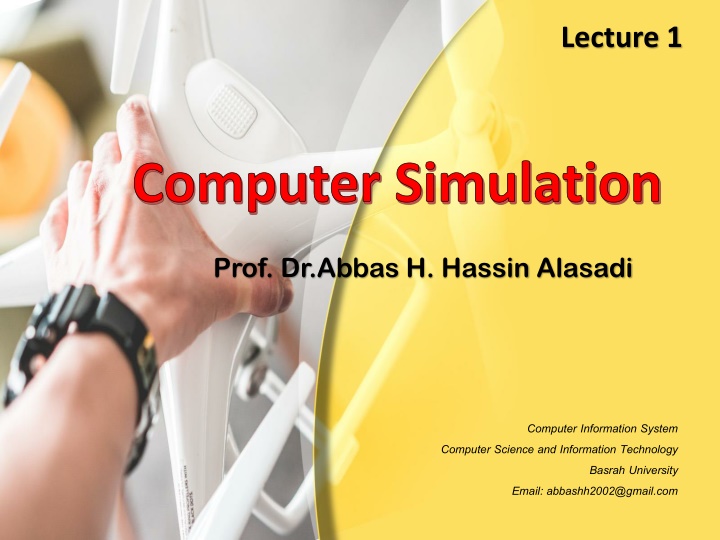
Computer Simulation and Systems Components Overview
Learn about computer simulation and systems components in this lecture by Prof. Dr. Abbas H. Hassin Alasadi from Basrah University. Understand the concept of systems, their components, modeling, and types of models. Explore examples of systems and how they interact with their environment.
Download Presentation

Please find below an Image/Link to download the presentation.
The content on the website is provided AS IS for your information and personal use only. It may not be sold, licensed, or shared on other websites without obtaining consent from the author. If you encounter any issues during the download, it is possible that the publisher has removed the file from their server.
You are allowed to download the files provided on this website for personal or commercial use, subject to the condition that they are used lawfully. All files are the property of their respective owners.
The content on the website is provided AS IS for your information and personal use only. It may not be sold, licensed, or shared on other websites without obtaining consent from the author.
E N D
Presentation Transcript
Lecture 1 Computer Simulation Prof. Dr.Abbas H. Hassin Alasadi Computer Information System Computer Science and Information Technology Basrah University Email: abbashh2002@gmail.com
2 Systems and System Environment A system is defined as a groups of objects that are joined together in some regular interaction toward the accomplishment of some purpose. An automobile factory: Machines, components parts and workers operate jointly along assembly line A system is often affected by changes occurring outside the system: system environment. Factory : Arrival orders Effect of supply on demand : relationship between factory output and arrival (activity of system) Banks : arrival of customers
3 Systems Components :An object of interest in the system : Machines in factory Attribute : The property of an entity : speed, capacity Activity :A time period of specified length :welding, stamping State :A collection of variables that describe the system in any time : status of machine (busy, idle, down, ) Event : A instantaneous occurrence that might change the state of the system: breakdown Endogenous ( ): Activities and events occurring with the system Exogenous( ): Activities and events occurring with the environment. Entity
4 Examples of Systems and their Components
5 Modelof a System To study the system it is sometimes possible to experiments with system This is not always possible (bank, factory, ) A new system may not yet exist Model: construct a conceptual framework that describes a system It is necessary to consider those accepts of systems that affect the problem under investigation (unnecessary details must remove)
6 Types of Models Models can be classified as being mathematical or physical. A mathematical model uses symbolic notation and mathematical equations to represent a system. A simulation model is a particular type of mathematical model of a system. A physical model is a larger or smaller version of an object such as the enlargement of an atom or a scaled-down version of the solar system.
The End of Lecture 1
